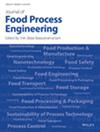Inactivation kinetics of Escherichia coli K12 in selected fruit juices determined by thermal-death-time disks
Abstract
Inactivation kinetics of Escherichia coli K12 inoculated in blueberry, grapefruit, cantaloupe, and watermelon juices were evaluated at isothermal temperatures of 52 to 62 °C using thermal death time disks. Juices had variations in titratable acidity, pH, viscosity, and total soluble solids. Survival curves were described by Weibull and linear models, where D- and z-values were determined using the first-order model. D-values in watermelon, cantaloupe, blueberry and grapefruit juices, were 6.57–0.64 min, 4.55–0.44 min, 3.94–0.27 min, and 3.03–0.24 min, respectively. The z-values of E. coli K12 in tested fruit juices ranged from 5.33 to 5.89 °C. While there were no significant differences in the z-values, the D-values varied significantly. According to the results obtained, pH and heating temperature dramatically affect the thermal resistance of E. coli K12 under tested conditions. These findings offer a basis for developing predictive models for E. coli inactivation in fruit juices.
Practical applications
Thermal death time (TDT) kinetics is extremely useful in ensuring microbial safety of fruit juices. The D- and z-values calculated in this study can contribute to developing predictive models for inactivating E. coli in fruit juices with varied physicochemical attributes. Furthermore, the data and models can be used for optimization of pasteurization processes and regulatory compliance. TDT studies provide the scientific basis for process calculations and help juice manufacturers comply with regulatory requirements. Also, TDT studies help determine the minimal thermal treatments needed to inhibit spoilage organisms, ensuring the juice remains safe and palatable for longer periods. This research will help scientists understand the thermal resistance of E. coli in various fruit juice matrices.


| 公司名称 | 产品信息 | 采购帮参考价格 |
|---|
 求助内容:
求助内容: 应助结果提醒方式:
应助结果提醒方式:


